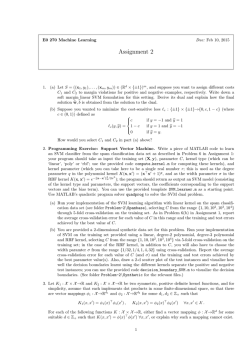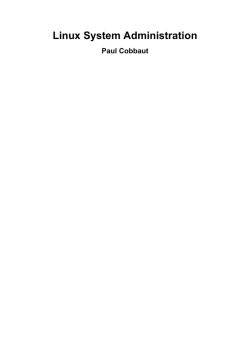
mcuio - Linino
LININO TECHNOLOGY Virtualizing MCU peripherals IoT dev room - FOSDEM 2015 [email protected] [email protected] Overview MPU physical link wireless link MCU MCU I2C PW M A/D GPI MPU: MicroProcessor Unit • Possibly SMP, large memory, few peripherals, full featured OS. • Designed for best average performance both in hw and in sw (multiple cache levels, virtual memory, multiple threads/processes, ...): real time is difficult. MCU: MicroController Unit • Single CPU, small memory, many peripherals, special purpose OS. • Much simpler: no cache, no VM: worst case execution times can be guaranteed. Conclusion: keep protocols and data processing on the MPU, real time stuff on the MCU. [email protected] Overview The Linino technology allows to integrate the MCU’s peripherals into the MPU as if they were standard Linux peripherals. Currently supported MCUs: • Atmel Atmega 32u4 (AVR core) • Freescale KL25z (Cortex M0+) • Nordic nRF51822 (Cortex M0) Currently supported MPUs: • Any MPU running Linux kernel >= 3.3 [email protected] Linino OS Linino IO works with works with Micro Processor Unit Micro Controller Unit MPU physical link wireless link Linino OS is opensource and it is based on OpenWRT (14.07 branch) distribution. Include about 3000 package built and available. Integrated with Linino IO it is a complete linux system for IoT space. MCU MCU I2C PWM A/D GPIO D/A DSP UART … Linino IO is based on THOS created by Alessandro Rubini. LininoIO is a software framework able to integrate MCU features inside the microprocessor environment. The source code is maintained by the Linino engineers staff and is opensource. [email protected] Hardware supported [email protected] Linino IO with Node.JS Overview • NODE.JS USERSPACE NODE.JS IDEINO-LININO-LIB LINUX KERNEL MODULES SYSFS LININO TECHNOLOGY • IDEINO-LININO-LIB https://github.com/ideino/ideino-linino-lib • SYSFS LINK MCU is a platform built on Chrome's JavaScript runtime for easily building fast, scalable network applications. Node.js uses an event-driven, non-blocking I/O model that makes it lightweight and efficient, perfect for data-intensive real-time applications that run across distributed devices MPU is a feature of the Linux 2.6 kernel that allows kernel code to export information to user processes via an in memory filesystem. The organization of the filesystem directory hierarchy is strict, and based the internal organization of kernel data structures. [email protected] Linino IO with Node.JS Live Demo BUZZ (pwm) board.tone(pin, frequency, duration, [callback]) BUTTON (digital input) board.digitalRead(pin, [callback]) OLED ctx.font = '13px Pixelade'; ctx.strokeText(data.hum_temperature " C", 5, 40); ctx.rect(1, 1, 127, 63); ctx.stroke(); board.display('OLED', ctx, canvas); LIFX var lifx = require('lifx'); lx.lightsOn(); lx.lightsColour(hue, saturation, luminance, whiteColour, fadeTime); DMESG [ 142.590000] gpiochip_add: registered GPIOs 200 to 215 on device: pca9555 [ 142.930000] sht21 0-0040: initialized [ 143.790000] ssd1307fb 0-003c: fb0: Solomon SSD1307 framebuffer device registered, using 1024 bytes of video memory [email protected] Linino IO wireless demo MPU wireless link • • MCU I2C PWM A/D GPIO D/A DSP UART … MPU is emulated by a PC MCU is Nordic nRF51822, Cortex M0 [email protected] The basic idea, a poor man’s PCI BUS0 MPU MCU MCU • Let the MPU see MCU peripherals like "local" devices. • Virtual MCU peripherals are accessed through memory-mapped registers. • Addressing based on: bus/ device/function/offset MCU FN0 FNp DEVICE0 DEVICE1 DEVICEm Max. 8 busses BUSn Max. 16 devices per bus Max. 32 functions per device Each function has a 4KB memory map MCU [email protected] The basic idea, a poor man’s PCI BUS0 MPU MCU MCU • Simple protocol: read/write from/to memory mapped registers. • The MCU can interrupt the MPU (via wire or MSI-like frames). • The MCU can in principle become "bus master”. • Unlike PCI, no separated configuration space. • Each virtual peripheral corresponds to a MCUIO function (FN). MCU FN0 FNp DEVICE0 DEVICE1 DEVICEm Max. 8 busses BUSn Max. 16 devices per bus Max. 32 functions per device Each function has a 4KB memory map MCU [email protected] The basic idea, a poor man’s PCI Function descriptor MSB LSB vendor class device rev 0 4 8 Frames have fixed size (16 bytes) -> easier implementation on MCU • 16 bytes is the size of a 16550 UART’s FIFO. • If DMA is available, frame reception is easier to implement if size is fixed. 0xfff [email protected] Linux implementation The mcuio bus LINUX KERNEL • The bus concept is the foundation of Linux device management. • Allows matching devices to drivers according to some specific criteria. • MCUIO uses device/vendor id or device class as match criteria. struct bus_type struct device struct device_driver HW HW DEVICE [email protected] Linux implementation A line discipline based HC USER SPACE /dev/ttySX KERNEL SPACE TTY A line discipline acts as a filter between the hardware and the kernel tty layer. MCUIO hc driver MCUIO Line discipline layer HW SERIAL PORT [email protected] Next steps • MCU support: • Atmel SAM D21 (Cortex M0+) • STM32 (Cortex M3) • any other? • Dynamic peripherals configuration • Wireless link support • BLE support (IPv6) • 802.15.4 support [email protected] You can find LininoIO code on github: MPU side (linux kernel): [email protected]:linino/kernel_3.3.8.git MCU side: [email protected]:linino/bathos-mcuio.git For any request of information, contact: Software development mailing list [email protected] Wiki http://wiki.linino.org/doku.php Any contribution is highly appreciated. [email protected]
© Copyright 2026








